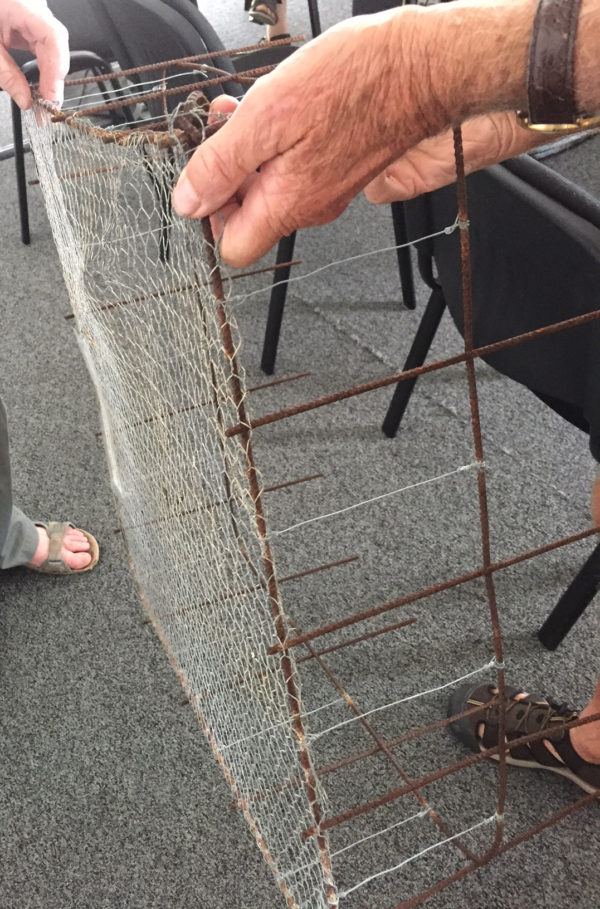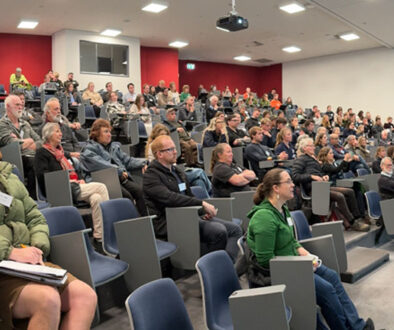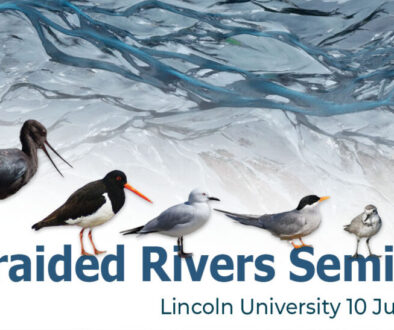Newsletter #37
Greetings,
At our last meeting in February, Ailsa’s Howard’s presentation on the use of ‘nesting cages’ on South Bay, Kaikoura, was impressive, to say the least. This method is proving to be a highly successful technique for saving nesting dotterels, with the added social engagement benefit of placing emphasis on ‘saving’ birds rather than ‘killing’ predators, something that has great appeal to community and school groups.
Until Ailsa experimented with the cages, the survival rate of chicks on South Bay was virtually nil; at the Braided Rivers seminar in June last year, Ailsa’s poster presentation was sub-titled ‘Empty Nest Syndrome‘. Trail cameras revealed that cats and dogs took chicks, while unleashed dogs disturbed nesting adults to the point where they became too frightened to stay on nests at night.
The nesting cages (called ‘exclosures’ in some of the literature) are designed so the gaps are large enough to allow adult birds to freely run in and out but small enough to keep out cats (even determined cats with long paws, as the trail cameras show) and dogs. Use of them has turned the previously abysmal statistic on its head: the adult dotterels returned to hatch a second and third egg rather than abandoning their nest after hatching just own or two. Adult birds are also visibly less anxious and more relaxed. By inference, fewer calories burned means potentially more time available for brooding.
The results speak for themselves: every ‘caged’ nest resulted in and at least one successful fledgeling. Ailsa is hoping to improve that statistic next year by trapping hedgehogs and cats, which still predate on chicks once they leave the safety of the cages.
The potential of these ‘nesting cages’ to protect dotterels and other small birds including wrybill from aerial predators (particularly the growing population of black-backed gulls) as well as cats, dogs, and possibly larger hedgehogs, is exciting. For more information and the (relatively simple and inexpensive) design specs of the ‘nesting cages’ specifically for dotterels, please contact Ailsa: ailsa@fishnet.co.nz. I’ve also added a couple of photos of the cages at the bottom of this page.
Links to peer-reviewed papers on ‘nesting cages’ or ‘exclosures’ elsewhere are listed below. If anyone else tries this method, please share your results! Knowing about what’s failed is just as important as learning about what’s worked.
Southern Black-backed gull (SBBG) numbers
A helicopter survey 01 November 2017 over the lower Waimakariri River from the mouth to the gorge, revealed 23 breeding colonies with 3,031 breeding pairs. In 2016, 5,015 breeding pairs were recorded (although the 2016 survey was done about 6 weeks earlier). From a personal perspective, in 2016 it was hard to tell where one breeding colony ended and another began. It’s certainly safe to say that these colonies are well entrenched.
Currently, there is little understanding (okay, no one has any idea) of the movements of SBBG around the greater Christchurch and Canterbury area. However, as we do know they number far fewer in the upper Waimakariri, BRaid will be undertaking a control programme to determine what impact, if any, that will be on the numbers of endemic braided river birds nesting in the area. As bird surveys were undertaken in the upper Waimakariri River in 2012, 2014, and 2016, we have a good baseline. This also will be a good test for the speed at which SBBG immigrate to the area once the existing SBBG colonies have been removed. If anyone would like any background information on predatory gulls, I spent an afternoon doing a rough review of the literature and compiled some notes here (thanks to Rachel McClellan for supplying some of the papers).
Trap making: volunteers needed
The trapping workshop held last year in Woodend has resulted in the formation of a new trapping group for the Ashley River estuary. Funds have now been secured to purchase materials for making 100 traps. The ARRG trapping expert, Geoff Swailes, has offered the use of his garage in Loburn, where the group have made hundreds of traps (which they also sell). Trap making will commence 08.30am Saturday, April 21. As many hands as possible are needed even if it is only for a few hours. BYO lunch and ear muffs. Also, if you have them – hammer and wire cutters (for mesh cutting), any power drill. Ideal opportunity to learn how to make traps. Please email nick.ledgard@xtra.co.nz if you are able to come.
Cheers,
Sonny Whitelaw
Manager
New reports and updates
- Island Creation: This ‘Quick guide to creating bird nesting islands‘ compiles what’s been learned on the Clarence and lower Waitaki Rivers these past few years.
- The Clarence River black-fronted tern restoration project 2017/2018 report is available here. Mike Bell’s paper in Nortornis is here. And a good article by Kate Guthrie (Predator Free NZ) explaining the ‘predator-free’ dilemma for migratory birds nesting on rivers is here.
- Mud Fish: Update from the Lower Waitaki
- Looking for specific reports? Use the search tool found at the bottom on BRaid’s front page, or at the top left of every other page. Reports on rivers are found on rivers pages by river name (see menu at left), and similarly about birds are on birds pages by bird name (see menu at left) and so on. Scroll down each of these pages until reaching Conservation Activities and/or Research, where most papers are kept.
- If you have previous research you would like to add, please email me as we are actively seeking historical reports, especially bird surveys, on braided rivers.
- Trapping plan for the Makorora River (courtesy of the recently formed Aspiring Biodiversity Trust)
Ground nesting bird ‘exclosure’ cages
- Managing predation on ground-nesting birds: The effectiveness of nest exclosures (Biological Conservation 136)
- Nest Predation Management: Effects on Reproductive Success in Endangered Shorebirds (Journal of Wildlife Management 72)
- Piping Plovers nesting at Presqu’ile after a 100-year absence (Conservation group newsletter: Ontario, Canada)
- Cages and emetics rescue wading birds: Decoy eggs injected with a drug to induce vomiting in predators (Science News)
- Nests, Eggs & Chicks (Nebraska Environmental Trust)
Other news
- Irrigation: Government cans Canterbury and Marlborough funding for irrigation (Stuff; 06 April)
- Rabbit Calicivirus: released nation-wide March/April this year (Stuff; 27 February)
- Who speaks for the rivers? What does it mean to give rivers the same status and legal rights as a person? (Stuff; 02 April)
- Seabird nesting times misaligned with changing food resources: Global phenological insensitivity to shifting ocean temperatures amongst seabirds (Nature Climate Change April 2018)
- Early birds may have been too hefty to sit on their eggs (Nature; 22 March: free access)
- Gene editing for conservation: Rethink public engagement (Nature; 21 March: free access)







